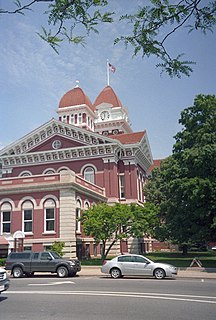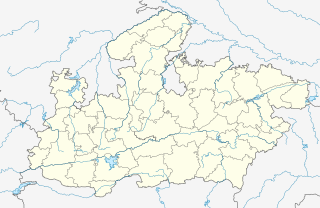Related Research Articles

The Dwight D. Eisenhower National System of Interstate and Defense Highways, commonly known as the Interstate Highway System, is a network of controlled-access highways that forms part of the National Highway System in the United States. Construction of the system was authorized by the Federal Aid Highway Act of 1956. The system extends throughout the contiguous United States and has routes in Hawaii, Alaska, and Puerto Rico.

The United States Numbered Highway System is an integrated network of roads and highways numbered within a nationwide grid in the contiguous United States. As the designation and numbering of these highways were coordinated among the states, they are sometimes called Federal Highways, but the roadways were built and have always been maintained by state or local governments since their initial designation in 1926.

Frederick Law Olmsted was an American landscape architect, journalist, social critic, and public administrator. He was the father of American landscape architecture. Olmsted was famous for co-designing many well-known urban parks with his senior partner Calvert Vaux. One of Olmsted's early works included designing the Walnut Hill Park in New Britain, Connecticut. His later efforts included Central Park and Prospect Park in New York City and Cadwalader Park in Trenton. He headed the pre-eminent landscape architecture and planning consultancy of late nineteenth-century America, which was carried on and expanded by his sons, Frederick Jr and John C, under the name Olmsted Brothers.

Public Works Administration (PWA), part of the New Deal of 1933, was a large-scale public works construction agency in the United States headed by Secretary of the Interior Harold L. Ickes. It was created by the National Industrial Recovery Act in June 1933 in response to the Great Depression. It built large-scale public works such as dams, bridges, hospitals, and schools. Its goals were to spend $3.3 billion in the first year, and $6 billion in all, to provide employment, stabilize purchasing power, and help revive the economy. Most of the spending came in two waves in 1933–35, and again in 1938. Originally called the Federal Emergency Administration of Public Works, it was renamed the Public Works Administration in 1935 and shut down in 1944.

Lake County is a county located in the U.S. state of Indiana. In 2010, its population was 496,005, making it Indiana's second-most populous county. The county seat is Crown Point. The county is part of Northwest Indiana and the Chicago metropolitan area, and contains a mix of urban, suburban and rural areas. It is the home to a portion of the Indiana Dunes and to Marktown, Clayton Mark's planned worker community in East Chicago.

Augusta, officially Augusta–Richmond County, is a consolidated city-county on the central eastern border of the U.S. state of Georgia. The city lies across the Savannah River from South Carolina at the head of its navigable portion. Georgia's second-largest city after Atlanta, Augusta is located in the Fall Line section of the state.

Indore is the most populous and the largest city in the Indian state of Madhya Pradesh. It serves as the headquarters of both Indore District and Indore Division. It is also considered as an education hub of the state and has campuses of both the Indian Institute of Technology and the Indian Institute of Management. Located on the southern edge of Malwa Plateau, at an average altitude of 553 meters (1,814 ft) above sea level, it has the highest elevation among major cities of Central India. The city is 190 km (120 mi) west of the state capital of Bhopal. Indore had a census-estimated 2011 population of 1,994,397 and 2,170,295. The city is distributed over a land area of just 530 square kilometres (200 sq mi), making Indore the most densely populated major city in the central province.
The Cross Island Parkway is a parkway in New York City; which is a part of the Belt System running along the perimeter of the boroughs of Queens and Brooklyn. The Cross Island Parkway runs 10.6 miles (17.1 km) from the Whitestone Expressway in Whitestone past the Throgs Neck Bridge, along and across the border of Queens and Nassau County to meet up with the Southern State Parkway. The road is designated as New York State Route 907A (NY 907A), an unsigned reference route, and bears the honorary name 100th Infantry Division Parkway.

Gardiner Greene Hubbard was an American lawyer, financier, and community leader.

The New York State Department of Transportation (NYSDOT) is the department of the New York state government responsible for the development and operation of highways, railroads, mass transit systems, ports, waterways and aviation facilities in the U.S. state of New York.

Major General Thomas Francis Farrell was the Deputy Commanding General and Chief of Field Operations of the Manhattan Project, acting as executive officer to Major General Leslie R. Groves, Jr.
New York State Route 294 (NY 294) is an east–west state highway in northern New York in the United States. It extends for just under 7 miles (11 km) from an intersection with NY 26 in the Lewis County town of Lewis to a junction with NY 46 in the Oneida County village of Boonville. The route serves the hamlet of West Leyden at its western terminus and the community of Redmond Center in the Oneida County town of Ava. NY 294 was assigned as part of the 1930 renumbering of state highways in New York.
New York State Route 23A (NY 23A) is an east–west state highway in Greene County, New York, in the United States. It serves as a 34.56-mile (55.62 km) alternate route of NY 23 through the northern Catskill Mountains. The route passes several of the Catskill High Peaks, including Hunter Mountain, before dropping into the Hudson Valley via Kaaterskill Clove and ending at an intersection with U.S. Route 9W (US 9W) in the village of Catskill. NY 23A was assigned in the mid-1920s and has not been changed since. A portion of the route through Kaaterskill Clove was closed for several months in 2006 after landslides triggered by heavy rains damaged the route.
Richard Frederick Daines was an American physician and served as the Commissioner of the New York State Department of Health from 2007 through 2010. Afterward, he was a visiting scholar at the New York Academy of Medicine, focusing on policies that promote obesity prevention.
The office of Superintendent of Public Works was created by an 1876 amendment to the New York State Constitution. It abolished the canal commissioners and established that the Department of Public Works execute all laws relating to canal maintenance and navigation except for those functions performed by the New York State Engineer and Surveyor who continued to prepare maps, plans and estimates for canal construction and improvement. The Canal Board continued to handle hiring of employees and other personnel matters. The Barge Canal Law of 1903 directed the Canal Board to oversee the enlargement of and improvements to the Erie Canal, the Champlain Canal and the Oswego Canal. In 1967, the Department of Public Works was merged with other departments into the new New York State Department of Transportation.

The State Trunkline Highway System consists of all the state highways in Michigan, including those designated as Interstate, United States Numbered, or State Trunkline highways. In their abbreviated format, these classifications are applied to highway numbers with an I-, US, or M- prefix, respectively. The system is maintained by the Michigan Department of Transportation (MDOT) and comprises 9,669 miles (15,561 km) of trunklines in all 83 counties of the state on both the Upper and Lower peninsulas, which are linked by the Mackinac Bridge. Components of the system range in scale from 10-lane urban freeways with local-express lanes to two-lane rural undivided highways to a non-motorized highway on Mackinac Island where cars are forbidden. The longest highway is nearly 400 miles (640 km) long, while the shortest is about three-quarters of a mile. Some roads are unsigned highways, lacking signage to indicate their maintenance by MDOT; these may be remnants of highways that are still under state control whose designations were decommissioned or roadway segments left over from realignment projects.
Arthur William Brandt was the New York State Superintendent of Public Works from March 30, 1939, to May 20, 1943.

St Barnabas Hospital is a non-profit hospital founded in 1866. The hospital is located in the Belmont neighborhood of The Bronx in New York City. The hospital is a level 2 adult trauma center.
Frederick Stuart may refer to:
References
- ↑ "Col. F.S. Greene, 69, Is Dead in Capital. New York State Public Works Commissioner Left His Post During Recent Illness. Highways Head 18 Years. Foe of Political Favoritism Under 3 Governors. Built War Rail Line in Argonne". Associated Press in the New York Times . March 27, 1939. Retrieved May 4, 2011.
Colonel Frederick Stuart Greene, until recently Commissioner of Public Works in New York State, died tonight in Emergency Hospital here of a blood ailment at the age of 69. He was admitted to the hospital yesterday. ...
- ↑ Weingroff, Richard F. (April 7, 2011). "From Names to Numbers: The Origins of the US Numbered Highway System". Highway History. Federal Highway Administration. Retrieved April 25, 2014.
- ↑ "Too Many Roads as U.S. Highways" . The New York Times . December 20, 1925. Retrieved April 25, 2014.